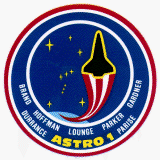|
|||||||||||||||||||
|
|
|||||||||||||||||||
|
|
The Flight of Astro-1
HUT was one of four telescopes included on the Astro-1 Spacelab mission, which flew aboard the space shuttle Columbia for nine days beginning Dec. 2, 1990. The spectacular night launch came more than 12 years after Hopkins scientists first conceived the project. The other Astro-1 telescopes included the Ultraviolet Imaging Telescope (UIT), the Wisconsin Ultraviolet Photo-Polarimeter Experiment (WUPPE), and the Broad-Band X-Ray Telescope (BBXRT).
Like HUT, each of these telescopes had been developed for a specialized task in helping to unravel some facet of the invisible universe. UIT gathered wide-field ultraviolet images. WUPPE analyzed the polarization characteristics of UV light. BBXRT obtained spectra in the X-ray region of the spectrum. The three ultraviolet telescopes were aligned and attached to the Instrument Pointing System (IPS), a Spacelab component developed for NASA by the European Space Agency, while BBXRT operated from a separate pointing system. These pointing systems allowed the astronauts and ground controllers to aim the telescopes precisely at astronomical targets even as the space shuttle orbited at 17,500 miles per hour.
Throughout the course of the Astro-1 mission a number of technical glitches with the IPS or other shuttle hardware occurred that threatened the observatory's ability to perform the scheduled observations. However, tremendous team work and ingenuity permitted most of the problems to be overcome, and Astro-1 was ultimately a spectacular scientific success. Before Astro-1, only a small handful of the brightest and hottest stars had been observed in HUT's far-UV wavelength range. On Astro-1, HUT scientists were able to make ground-breaking observations of many classes of objects, including active galaxies, quasars, elliptical galaxies, cataclysmic variable binary stars, supernova remnants, and much more.
Over 40 hours of actual observation time was obtained on 77 unique astronomical targets by HUT during Astro-1, and over 50 scientific papers were produced by team members. Combined the four instrument teams had published over 120 papers at last count, with others still in preparation. This made the Astro-1 mission one of the most successful scientific shuttle missions to date, despite the operational difficulties that occurred! On Astro-1, HUT "opened the window" to the far-UV spectrum for general scrutiny and provided our first detailed look at many types of objects. (Link to Scientific Results from HUT for a description of some of these findings.)
|
|
|




 Follow Us
Follow Us
 The Astro-1 flight crew
The Astro-1 flight crew